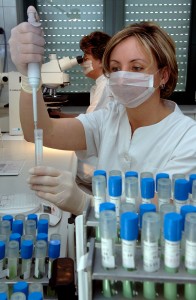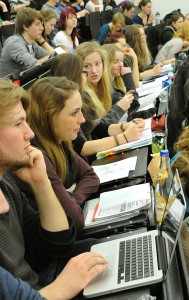 The grim reality and rays of hope
The grim reality and rays of hope
A common refrain doing the rounds in Davos was that Europe is losing ground in terms of innovation and competitiveness. Now the World Economic Forum in collaboration with Roland Berger Strategy Consultants has published an inside report entitled “Rebuilding Europe’s Competitiveness”. It makes for grim reading.
Falling behind
While in the first decades of the European Community the productivity gap (defined by GDP per hour worked) to the US was closing rapidly, it has more or less remained static since the 1980s. The problem was eventually identified but ultimately not resolved. The Lisbon Strategy was an action-and -development plan created by the European Council in 2000 and it was supposed to rejuvenate the European Union’s economy by 2010. Its mission was to make the EU “the most competitive and dynamic knowledge-based economy in the world capable of sustainable economic growth with more and better jobs and greater social cohesion.” It goes without saying that most of its goals were never accomplished. With Americans working longer hours, the per capita gap in GDP between theUSand the EU has once more begun to widen.
What do you do when your plan does not work? You devise a new one. They did and it is called Europe 2020. The EU’s official statement is “Europe 2020 is the EU’s growth strategy for the coming decade. In a changing world, we want the EU to become a smart, sustainable and inclusive economy. These three mutually reinforcing priorities should help the EU and the member states deliver high levels of employment, productivity and social cohesion.” The authors of the Competitiveness-report obviously think that more effort is required.
A dozen pillars of success
The Roland Berger report tries to capture the many different and interrelated factors which have an impact on competitiveness as set out in the 12 pillars from The Global Competitiveness Index (GCI). According to the report, the US consistently outperforms the EU 27 average across almost all pillars with Europe lagging behind in three areas in particular: innovative capacity i.e. the capacity to generate and to use knowledge to create new products and processes to add more value; higher education and training systems which are required to develop the skills needed to power a knowledge based economy; and the creation of an efficient labor market which allows for effectively mobilizing the talent available in a country.
European north-south divide
Northern Europe consistently outperforms southern Europe in terms of overall competitiveness. Although both northern and southern European countries have registered improvements since the 1980s, their paths have been slowly but steadily diverging. The north-south competitiveness-divide within Europe, the main reason for the Euro Crisis, is characterized by wide divergences in competitiveness across all 12 pillars of the GCI, with performance mostly on par with the US in the north and far weaker performance in the south, especially in terms of institutional capacity. The ‘Institutions Pillar’ of the GCI captures factors such as the efficiency of government institutions, the degree of corruption and undue influence, the protection of property rights and physical security. To a large extent, this pillar encapsulates the capacity of the public sector to introduce and enforce measures essential for an efficiently run economy. Improvements in institutions can generate spillovers into other dimensions of competitiveness.
Best-practice case studies
The competitiveness divide in the Eurozone can no longer be bridged by devaluation, it needs to be mended. The report identifies best-practice competitiveness measures across Europe that worked well and can serve as an inspiration for countries willing to reform. Three focal points are: (1) develop and mobilize talent, (2) enhance innovation and support entrepreneurship, and (3) use the full potential of liberalizing product and service markets. Case studies from all three focal areas include:
• Dutch leading technology institutes
• Basque region R&D policy (Spain)
• Hartz labor market reforms (Germany)
• Danish flexicurity model
• German dual system of apprenticeships
• Finnish education reforms
• Swedish network liberalization
 The report concludes with the statement, “In order to maximize success, countries can find inspiration and learn from past practices that have shown that coherent and well-explained reform schemes building on multistakeholder partnerships, policy consistency and continuity, along with sustained political leadership, provide good results.” It continues, “Several European countries have adopted significant competitiveness-oriented reforms in the past, while preserving the European values of efficiency and cohesion. The selected competitiveness practices presented in this Report can provide policy-makers with initial inspiration on which competitiveness reforms and measures could be pursued, and how.”
The report concludes with the statement, “In order to maximize success, countries can find inspiration and learn from past practices that have shown that coherent and well-explained reform schemes building on multistakeholder partnerships, policy consistency and continuity, along with sustained political leadership, provide good results.” It continues, “Several European countries have adopted significant competitiveness-oriented reforms in the past, while preserving the European values of efficiency and cohesion. The selected competitiveness practices presented in this Report can provide policy-makers with initial inspiration on which competitiveness reforms and measures could be pursued, and how.”
Do not waste a crisis
The report states that “clearly, more competitive economies are able to produce higher levels of income for their citizens.” So, instead of a strategy for rebuilding competiveness they should have called it a strategy for growth. This would also have avoided the misconception that economies with productivity at par with the US can be allowed to rest on their laurels. In the current sovereign debt crisis, growth strategies are often called for as an alternative or at least a correlate to austerity. A possible reason why the authors of the report did not highlight growth may be that, in some quarters at least, economic growth is no longer a credible objective as they doubt the power of material wealth to enhance happiness. Concentrating on competitiveness avoids this pitfall.
All reforms, however necessary, face strong resistance because those set to lose out are very vocal, while the eventual winners are not easily identified and remain silent.
Jean-Claude Juncker, former President of the Euro Group, was quoted far and wide when he said “We all know what to do; we just don’t know how to get re-elected after we’ve done it.” There are some strategies reformers can use to get re-elected though. One is the sharing of the blame. If all stakeholders are in the same boat perhaps they will think twice about rocking it. So the need for multistakeholder partnerships in developing and implementing competitiveness-enhancing reforms is touted throughout the report, pointing out that “the current difficulties could and should be regarded as a call for transformational action to better adapt Europe to a new competitive environment.” In other words, this crisis should not be wasted. It is a unique opportunity to form multistakeholder partnerships.
Politicians and the public
There is however another time-honored strategy to get big reformers re-elected, namely, the shifting of the blame to past governments or outside pressure. Reforming politicians can use this to align themselves with the general public, presenting themselves as co-victims rather than culprits, all the while expressing their sincere regrets at being unable to continue featherbedding their clientele. This strategy should not be passed over if it enables politicians to roll out unpopular reforms. A recent survey on development aid revealed that a broad majority of recipients would in fact prefer more conditions rather than just cash with no strings attached.
Necessary but unpopular reforms need all the support they can get. Without the frequent use of Angela Merkel as a lightning rod, the pace of reforms inSouthern Europewould almost certainly be even more glacial. Of course this strategy only works when it remains a secret. It goes without saying that the report does not mention it.
Dr. Helmut Henschel is a Senior Consultant, founding president of the German CFA Society and former Managing Director of WestLB Research GmbH
